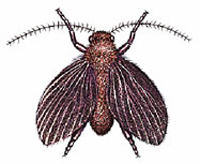|  Drain
Flies Drain
Flies
Order: Diptera
Family: Psychodidae
Scientific Name: Various, Psychoda spp. and Telmatoscopus
spp.
Color: Yellow to brown /black
Legs: Six
Shape: Cylindrical
Size: Adults range in size from 1/16 to º inch
Antennae: Yes
Flight: Yes, although poor
Also called moth flies, sewer flies or filter flies these true
flies have bodies and wings covered with numerous Their life cycle
is 7 to 20 days. Adult flies have the body and wings covered with
dense, long hairs. If crushed they leave a powdery smudge. Their
life cycle is 7 to 20 days.
Habits
Drain flies or moth flies can become an annoyance when they breed
in liquids in drains,dirty garbage containers and other organic
debris areas. They become a problem when they reach large numbers.
Adult flies are poor fliers and are more active at night. Adults
feed on nectar and polluted water.
Habitat
Drain flies, or moth flies, can be found in moist, highly organic
debris areas such as sink drains, sewage treatment facilities, storm
drains, dung and rotten vegetation. They may be common in laundry
and floor drains, toilet and shower drains. Floor drains, overflow
cuts in sinks and tubs, sump pump pits and sewers can accumulate
organic matter but often do not receive enough water to flush the
waste down the drain. During daylight, adults will often be found
resting on walls near drains. Adults live about two weeks.
Threats
Most moth flies are harmless to humans, though they may transmit
bacteria and other microorganisms from their breeding sites to areas
where people are. Moth flies do not bite.
Control
Finding the sources of breeding and eliminating them is the best
control. Control varies with the origin of the moth fly infestation.
The most economical and sanitary way is to remove the organic material
in which they breed. This requires cleaning sinks, drain pipes,
and traps with a stiff wire brush or by steam. Some control of the
maggots can be obtained by flushing infested drains with a caustic
household cleaner, or by running the hot water down the drain for
a period of time. To determine which drain is infested, place a
jar over the outlet or tape a plastic bag over the opening of the
overflow outlet. Check the container at intervals for adult flies.
(Source: National Pest Management Association, et. al.)
|